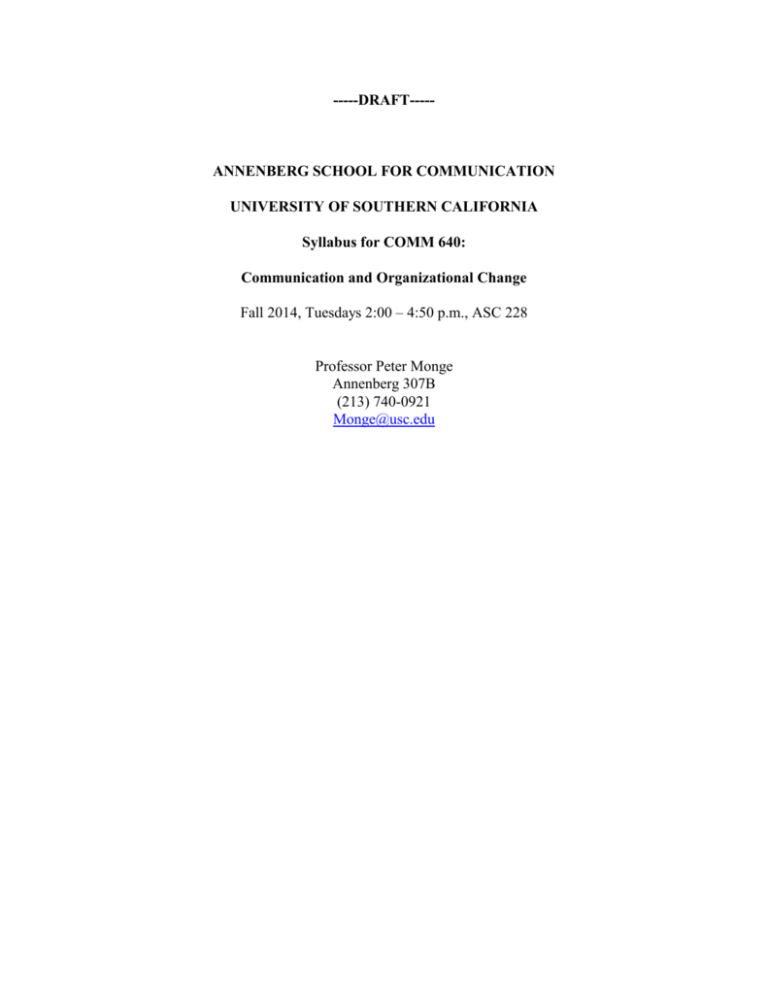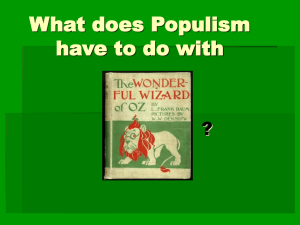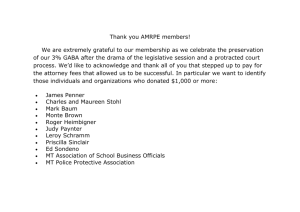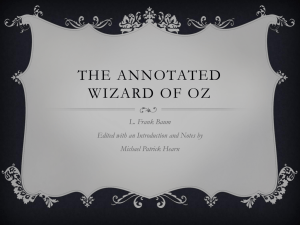annenberg school for communication
advertisement

-----DRAFT----- ANNENBERG SCHOOL FOR COMMUNICATION UNIVERSITY OF SOUTHERN CALIFORNIA Syllabus for COMM 640: Communication and Organizational Change Fall 2014, Tuesdays 2:00 – 4:50 p.m., ASC 228 Professor Peter Monge Annenberg 307B (213) 740-0921 Monge@usc.edu Page 2 Course Description Theories of evolution have risen to the forefront of the social sciences over the past decade. Applications to organization theorizing and research have increased dramatically. Information and communication are integral aspects of evolutionary thinking at all levels. This doctoral seminar examines evolutionary theorizing and research in the areas of communication and organizations to see how each informs the other. The course begins with a general overview of theories that have been used in organizational communication research over the years. This includes system theories, structuration theory, critical theory, and institutional theory. Given this background, we then turn to evolutionary theory to identify its primary arguments, essential claims, and modes of analysis. Following this introduction, the course is organized around communication processes which occur in evolutionary processes: entrepreneurial activity and organizational foundings, intraorganizational evolution and managerial choice, organizational evolution, populations and coevolution, environments and niches, communities of organizations, and the entire ecological system. In these areas attention is focused on primary information processes in organizations, including searching, retrieving, interpreting, and learning. Routines, capabilities, networks, boundaries, and environments are crucial locations in which these information processes occur and each location processes information in unique ways. Central to these activities are the communication technologies and social influences that affect the processing. Throughout the course, a number of important methodological issues are explored, including dynamic theorizing, longitudinal research and multilevel analysis. Students will also choose topics and work with me to organize class discussions and supplementary materials each week. Texts and Readings Required: Aldrich, H., & Ruef, M. (2006). Organizations evolving (2nd ed.). Thousand Oaks, CA: Sage. Baum, J.A.C., & McKelvey, B. (Eds.). (1999). Variations in organization science: In honor of Donald T. Campbell. Thousand Oaks, CA: Sage. Baum, J.A.C., & Singh, J.V. (Eds.) (1994). Evolutionary dynamics of organizations. New York: Oxford University Press. Carroll, G. R., & Hannan, M. T. (2000). The Demography of Corporations and Industries. Princeton, NJ: Princeton University Press. A number of other journal articles and book chapters will be made available in pdf format on the course website throughout the semester. Page 3 Recommended: Baum, J. A. C. (Ed.). (2002). The Blackwell companion to organizations. Malden, MA: Blackwell Hawley, A. H. (1986). Human ecology: A theoretical essay. Chicago: U. of Chicago Press. Nelson, R.R., & Winter, S. (1982). An evolutionary theory of economic change. Cambridge, MA: Belknap. Putnam, L. L., & Mumby, D. K. (Eds.). (2013). The SAGE handbook of organizational communication: Advances in theory, research, and methods (3rd. ed.). Los Angeles, CA: Sage. Evaluation Your grade in this course will be assigned on the basis of a term paper. The paper should focus on an important topic in organizational communication from one of the evolutionary theoretical perspectives reviewed in this class. The paper can be theoretical or empirical. A three-page topic proposal is due on October 14. I will set up times throughout the semester when we will get together to discuss your ideas and progress. A draft of the complete paper is due on November 25, but I will gladly read earlier drafts or portions of papers. You should also select a student colleague from the class to provide feedback on the November 25th draft. I will also provide you with comments. The last day of class, December 2, will be devoted to presentations of the papers. The final version of the paper is due on December 9. Papers should be written in accordance with the guidelines contained in the Publication Manual of the American Psychological Association (2008, 6th ed.); copies are available in the library and the bookstore. All proposals, drafts, and final versions of the paper should be submitted as electronic Word files attached to an email message addressed to monge@usc.edu. I will return your papers to you as Word files with feedback posted as electronic comments. Academic Integrity The School of Communication is committed to the highest standards of ethical conduct and academic excellence. Any student found guilty of plagiarism, fabrication, cheating on examinations, purchasing papers or other assignments, or any other form of academic dishonesty will receive a failing grade in the course from the instructor and the School Page 4 will recommend that the student be dismissed from the Communication program. There are no exceptions to this policy. Course Outline August 26: Introduction to the class Introductions Review the syllabus and texts Discuss revisions of the class according to student interests September 2: Overviews of Evolutionary & Ecological Theory in Organizational Study Aldrich & Ruef (2006). Cps. 1-3 Usher, J. M., & Evans, M. G. (1996). Life and death along gasoline alley: Darwinian and Lamarckian Processes in a differentiating population. Academy of Management Journal, 39, 1428-1466. Galunic, D. C., & Weeks. J. R. (2002). Intraorganizational ecology. In Baum (2000), Cp. 3 Warglien, M. (2002). Intraorganizational evolution. In Baum (2002), Cp. 4 Baum, J.A. C., & Amburgey, T. L. Organizational Ecology. In Baum (2002), Cp. 13. Rao, H. Interorganizational ecology. In Baum (2002), Cp. 23. September 9: Traditional Theoretical Approaches to Organizational Communication Poole, M. S. (2013). Systems theory. SHOC. Cp. 2. McPhee, R. D., Poole, M. S., & Iverson. J. (2013). Structuration theory. SHOC, Cp. 3. Mumby, D. K. (2013). Critical Theory and Postmodernism. SHOC, Cp. 4. Lammers, J. C., & Garcia, M. A. (2013). Institutional Theory, SHOC, Cp. 8 September 16: Classic Views of Organizational Evolutionary and Ecological Theories Page 5 Campbell, D. T. (1965). Variation and selective retention in socio-cultural evolution. In H.R. Barringer, G.I. Blanksten, & R.W. Mack (Eds.), Social change in developing areas: A reinterpretation of evolutionary theory (pp. 19-48). Cambridge, MA: Schenkman. DiMaggio, P. J., & Powell, W.W. (1983). The iron cage revisited: Institutional isomorphism and collective rationality in organizational fields. American Sociological Review, 48, 147-160. Hannan, M.T., & Freeman, J.T. (1977). The population ecology of organizations. American Journal of Sociology, 85, 929-964. Hannan, M.T., & Freeman, J.T., (1984). Structural inertia and organizational change. American Sociological Review, 49, 149-164. Nelson, R.R., & Winter, S. (1982). An evolutionary theory of economic change. Cambridge, MA: Belknap. Cp.5 Hawley, A. H. (1986). Human Ecology: A theoretical essay. Chicago: U. of Chicago Press. Cps. 1, 2, 7 September 23: Organizational, Population, and Community Foundings Aldrich & Ruef (2006), Cp. 4, 5 Anderson, P. Venture capital dynamics and the creation of variation through entrepreneurship. In Baum & McKelvey, Cp. 8 Audia, P., Freeman, J. H. , & Reynolds, P. D. (2006), Organizational Foundings in Community Context: Instruments Manufacturers and Their Interrelationship with Other Organizations. Administrative Science Quarterly, 51, 381-419. Delacroix, J. & Carroll, G. R. (1983). Organizational foundings: An ecological study of the newspaper industries of Argentina and Ireland. Administrative Science Quarterly, 28, 631-661. Miner, A. (1994). Seeking adaptive advantage: Evolutionary theory and managerial action. In Baum & Singh, Cp. 5. Swaminathan, A. (1996). Environmental conditions at founding and organizational mortality: A trial-by-fire model. Academy of Management Journal, 39, 13501377. Optional Reading Page 6 Cattani, G., Pennings, J. M., & Wezel, F. C. (2003). Spatial and temporal heterogeneity in founding patterns. Organizational Science, 14, 670-685. September 30: Organizational, Population, and Community Forms and Structures Aldrich and Ruef (2006), Cps. 6. Carroll, G. R., & Hannan, M. T. (2000). The Demography of Corporations and Industries. Princeton, NJ: Princeton University Press. Cp. 4: Forms and Populations, and Cp. 6: Analyzing Corporate Vital Rates. Hsu, G., & Hannan, M. T. (2005). Identities, genres, and organizational forms. Organization Science, 16, 474-490. McKendrick, D. G., & Carroll, C. (2001). On the genesis of organizational forms; Evidence from the market for disk arrays. Organization science, 12(6), 661-682. Rao, H., & Singh, J.T. (1999) Types of variation in organizational populations. In Baum & McKelvey Cp. 4. Optional Reading Djelic, M., & Ainamo, A. (1999). The coevolution of new organizational forms in the fashion industry: A historical and comparative study of France, Italy, and the United States. Organization Science, 10, 622-637. Dijksterhuis, M. S., Van den Bosch, F. A. J., & Volberda, H. W. (1999). Where do new organizational forms come from? Management logics as a source of coevolution. Organization Science, 10, 596-582. Ruef, M. (2000). The emergence of organizational forms: A community ecology approach. American Journal of Sociology, 106, 658-714. October 7: Fundamental Processes: Variation, Selection, and Retention Romanelli, E. (1999). Blind (But Not Unconditioned) Variation. In Baum and McKelvey, Cp. 5. Feldman, M. (2000). Organizational routines as a source of organizational change. Organization Science, 11, 611-629. March, J. G. (1994). The Evolution of evolution. In Baum & Singh, Cp. 3 Schultz, M. (1998). Limits to bureaucratic growth: The density dependence of organizational rule births. Administrative Science Quarterly, 43, 845. Page 7 Minor, A.S., & Raghavan, S.V. (1999). Interorganizational imitation: A hidden engine of selection. In J.A.C. Baum & B. McKelvey (Eds.), Variations in organizations: In honor of Donald T. Campbell (pp. 35-62). Thousand Oaks, CA: Sage. Carroll, G. R., & Hannan, M. T. (2000). The Demography of Corporations and Industries. Princeton, NJ: Princeton University Press. Cp. 7: Modeling Corporate Vital Rates. October 14: Density Dependence, Adaptation and Survival: Fitness & Fitness Landscapes Carroll, G. R., & Hannan, M. T. (2000). The Demography of Corporations and Industries. Princeton, NJ: Princeton University Press. Cps 9 – 11, and 17: Organizational Environments, Density-Dependent Processes I, Density-Dependent Processes II, and Organization Theory. Barnett, W. P. (1997). The dynamics of competitive intensity. Administrative Science Quarterly, 42, 128-160. Levinthal, D.A., & Warglien, M. (1999). Landscape design: Designing for local action in complex worlds. Organization Science, 10, 342-357. Research Paper Proposal Due October 21: Organizational Niches and Environments: Resource Partitioning Theory Carroll & Hannan, Cp. 12: Segregation processes. Dimmick, J. W. (2003). Media competition and coexistence: the theory of the niche. Mahwah, NJ: Erlbaum. Cps. 3-4. Polodny, J. M., Stuart, T. E., & Hannan, M. T. (1996). Networks, knowledge, and niches: Competition in the worldwide semiconductor industry, 1984-1991. American Journal of Sociology, 102, 659-689. Carroll, G. R., Dobrev, S. D., & Swaminathan, A. (2002). Organizational processes of resource partitioning. Research in Organizational Behavior, 24, 1-40. Swaminathan, A. (1995). The proliferation of specialist organizations in the American wine industry, 1941-1990. Administrative Science Quarterly, 40, 653680. Hannan, M. T., Carroll, G. R., & Polos, L. (2003). The organizational niche. Sociological Theory, 21(4), 309-340. Page 8 Recommended Reading: Dimmick, J. W. (2003). Media competition and coexistence: the theory of the niche. Mahwah, NJ: Erlbaum. Cps. 1, 2. Ruef, M., & Scott, W. R. (1998). A multidimensional model of organizational legitimacy: Hospital survival in changing institutional environments. Administrative Science Quarterly, 43, 877-904. Freeman, J., & Lomi, A. (1994). Resource partitioning and foundings of banking cooperatives in Italy . In Baum and Singh, Cp. 14 Hsu, G. (2006). Jacks of all trades and masters of none: Audiences' reactions to spanning genres in feature film production. Administrative Science Quarterly, 51(3), 420-450. October 28: Mutual, Competitive, and Symbiotic Processes Astley, W. G. (1985). The two ecologies: Population and community perspectives on organizational evolution. Administrative Science Quarterly, 30, 224-241. Hunt, C. S., & Aldrich, H. E. (1998). The second ecology: Creation and evolution of organizational communities. Research in Organizational Behavior, 20, 267-301. Barnett, W. P., & Carroll, G. R. (1987). Competition and mutualism among early telephone companies. Administrative Science Quarterly, 32, 400-421. Lawless, M. W., & Anderson, P. C. (1996). Generational technological change: Effects of innovation and local rivalry on performance. Academy of Management Journal, 39, 1185-1217. Dobbin, F., & Dowd (1997). How policy shapes competition: Early railroad foundings in Massachusetts. ASQ, 42, 501-529. Amburgey, T. L., Dacin, T., & Kelly, D. (1994). Disruptive selection and population segmentation: Interpopulation competition as a segregation processes. In Baum and Singh, Cp. 12 Optional Reading Simons, T., & Ingram, P. (2003). Enemies of the state: The interdependence of institutional forms and the ecology of the Kibbutz, 1910-1997. ASQ, 48, 592-621. Page 9 November 4: Organizational, Population, and Community Learning Aldrich & Ruef (2006), Cp. 6 March, J. G. (1991). Exploration and exploitation in organizational learning. Organization Science, 2, 5-24. Kogut, B., & Zander, U. (1996) What firms do? Coordination, identity, and learning. Organization Science, 7, 502-518. Mezias, S.J., & Lant, T.K. (1994). Mimetic learning and the evolution of organizational populations. In Baum & Singh, Cp. 10. Lee, G. E., & Cole, R. E. (2003). From a firm-based to a community-based model of knowledge creation: The case of the Linux kernel development. Organization Science, 14, 633-649. November 11: Replication and Coevolution Aldrich & Ruef (2006), Cps 9 & 11. Carroll, G. R., & Hannan, M. T. (2000). The Demography of Corporations and Industries. Princeton, NJ: Princeton University Press. Cps. 13 & 14: Age Dependent Processes, and Size Dependent Processes. Baum, J.A.C. (1999). Whole-Part coevolutionary competition in organizations. In J. A.C. Baum & B. McKelvey (Eds.), Variations in organizations: In honor of Donald T. Campbell (pp. 113-135). Thousand Oaks, CA: Sage. Van de Ven, A.H., & Garud, R. (1994). The coevolution of technical and institutional events in the development of an innovation. In Baum & Singh, Cp. 20. Rosenkopf, L., & Tushman, M. L. (1994). The coevolution of technology and organization. In Baum & Singh, Cp. 19. Monge, P., & Contractor, N. (2003). Theories of communication networks, Cp. 9. November 18: (NCA) Transformation: Change and Inertia Aldrich & Ruef (2006), Cps. 7, 8 Page 10 Carroll, G. R., & Hannan, M. T. (2000). The Demography of Corporations and Industries. Princeton, NJ: Princeton University Press. Cp. 16: Organizational Transformation. Barnett, W. P.. & Carroll, G. R. (1995). Modeling Internal Organizational Change. Annual Review of Sociology, 21, 217-236. Gersick, C.J.G. (1991) Revolutionary change theories: A multilevel exploration of the punctuated equilibrium paradigm. Academy of Management Review, 16, 1036. Powell, Walter W., White, Douglas R, Koput, Kenneth, and Owen-Smith, Jason. Network dynamics and field evolution: The Growth of Interorganizational Collaboration in the Life Sciences, 2004. AJS. Sydow, J., Schreyogg, G., & Koch, J. (2009). Organizational Path Dependence: Opening the Black Box. Academy of Management Review , 34, 689-709. Tushman, M. L., & Romanelli, E. (1985). Organizational evolution: A metamorphosis model of convergence and reorientation. In L. L. Cummings & B. M. Shaw (Eds.), Research in Organizational Behavior, 7, 171-222. Optional Readings Barron, D. N. (1999). The structuring of organizational populations. American Sociological Review, 64, 421-445. Van de Ven, A. H., & Poole, M. S. (2002) Field Research Methods. In Baum (2002), Cp. 38 (Read Pps. 867-873) For a fuller explication, see the entire chapter or Poole, M. S., Van de Ven, A. H., Dooley, K., & Holmes, M. E. (2000). Organizational change and innovation processes: Theory and methods for research. New York: Oxford University Press. Cp. 3 (A Typology of Process Theories) November 25: Maturation and Intergenerational Transfer, Obsolescence and Death Aldrich, H., Zimmer, C. R., Staber, U. H., & Beggs, J. J. Minimalism, mutualism, and maturity: The evolution of the American trade association in the 20th Century. In Baum & Singh, Cp. 11. Barnett, W. P. (1990). The organizational ecology of a technological system. Administrative Science Quarterly, 35, 31-60. Page 11 Phillips, D. (2005). Organizational genealogies and the persistence of gender inequality: The case of Silicon Valley law firms. Administrative Science Quarterly, 50, 447-442. Van de Ven, A. H., & Grazman, D. N. (1999). Evolution in a nested hierarchy: A genealogy of twin cities health care organizations, 18953-1995. In Baum & McKelvey, Cp. 11 Aldrich & Ruef (2006), Cp. 10 Usher, J. M., & Evans, M. G. (1996). Life and death along gasoline alley: Darwinian and Lamarckian processes in a differentiating population. Academy of Management Journal, 39, 1428-1466. Barron, D. N., West, E., & Hannan, M. T. (1994). A time to grow and a time to die: Growth and mortality of credit unions in New York City, 1914-1990. American Journal of Sociology, 100, 381-421. Delacroix, J., Swaminathan, A., & Solt, M. E. (1989). Density dependence versus population dynamics: An ecological study of failings in the California wine industry. American Sociological Review, 54, 245-262. Baum, J. A. C., & Oliver, C. (1991). Institutional linkages and organizational mortality. ASQ, 36, 187-218. Bruderl, J., & Schissler, R. (1990). Organizational mortality: The liabilities of newness and adolescence. ASQ, 35, 530-547. Draft of final paper due Optional Topic and Readings: Complex Adaptive Systems Kauffman, S. (1993). The origins of life: Self-organization and selection in evolution. New York: Oxford University Press. Cp. 2. (Also helpful on the same topics is Kauffman, S. (1995). At home in the universe: The search for the laws of self-organization and complexity. New York: Oxford University Press, Cps. 2, 3, & 8; see also Cps. 10 & 11) Eisenhardt, K.M., & Bhatia, M.M. (2002). Organizational Complexity and Computation. In Baum (2002). Cp. 19. Morel, B., & Ramanujam, R. (1999). Through the looking glass of complexity: The dynamics of organizations as adaptive and evolving systems. Organization Science, 10, 278-293. Page 12 McKelvey, B. (1999). Avoiding complexity catastrophe in coevolutionary pockets: Strategies for rugged landscapes. Organization Science, 10, 294-321. Anderson, D. (1999). Complexity theory and organization science. Organization Science, 10, 216-232. Boisot, M. & Child, J (1999). Organizations as adaptive systems in complex environments: The case of China. Organization Science, 10, 237-252. December 2: Paper presentations December 9: Final Paper Due Additional References Abbott, A. A primer on sequence methods. Organization Science, 1, 375-392. Aldrich, H. A., & Kenworthy, A. L. (1999). The accidental entrepreneur: Campbellian antinomies and organizational foundings. In Baum & McKelvey, Cp. 2. Astley, W.G., & Fombrun, C.J. (1987). Organizational communities: An ecological perspective. Research in the Sociology of Organizations, 5, 163-185. Axelrod, R., & Cohen, M. (2000). Harnessing Complexity. New York: The Free Press. Barnett, W.P. (1994). The liability of collective action: Growth and change among early American telephone companies. In Baum & Singh, Cp. 16. Barnett, W. P., Greive, H. R., & Park, D. Y. (1994). An evolutionary model of organizational performance. Strategic Management Journal, 15, 11-28. Baum, J. A. C., & Singh, J V. (1994). Organization-Environment Coevolution. In Baum & Singh, Cp. 18 Baum, J. A. C. (1996). Organizational Ecology. In S. R. Clegg, C. Hardy & W. R. Nord (Eds.), Handbook of Organization Studies (pp. 77-114). Thousand Oaks, CA: Sage. Brittain, J. (1994). Density-independent selection and community evolution. In Baum & Singh, Cp. 17. Page 13 Brittain, J. W., & Wholey, D. H. (1988). Competition and coexistence in organizational communities: population dynamics in electronics components manufacturing. In G. R. Carroll (Ed.), Ecological Models of Organizations (pp. 195-222). Cambridge, MA: Ballinger. Bryant, J. A., Shumate, M.D., & Monge, P.R. (2002). Globalization and coevolving communities: The licit, the illicit, and the legal. (Under review) Burgelman, R. A., & Mittman, B. An intraorganizational ecological perspective on managerial risk behavior, performance, and survival: Individual, organizational, and environmental effects. In Baum and Singh, Cp. 4. Campbell, D. G. (1994). How individual and face-to-face group selection undermine firm selection in organizational evolution. In Baum & Singh, Cp. 2. Carroll, T., & Burton, R. (1999). Exploring “complex’ organizational designs. Unpublished paper, Duke University. Carroll, G. R., & Hannan, M. T. (2000). The Demography of Corporations and Industries. Princeton, NJ: Princeton University Press. Cp. 5, 6, 8. Contractor, N. (1994). Self-organizing systems perspective in the study of organizational communication. In B. Kovacic (Ed.), New approaches to organizational communication (pp. 39-66). Albany: State University of New York Press. Contractor, N.S. (1999). Self-organization systems research in the social sciences: Reconciling the metaphors and the models. Management Communication Quarterly, 13, 154-166. Dimaggio, P. (1994). The challenge of community evolution. In Baum & Singh, Pp. 444-450. Drazin, R., & Sandelands, L. (1992). Autogenesis: A perspective on organizing. Organization Science, 3, 230-249. Eisenhardt, K. M., & Schoonhoven, C. B. (1990). Organizational growth: Linking founding team strategy, environment, and growth among U.S. semiconductor ventures, 1978-1988. Administrative Science Quarterly, 35, 504-529. Ginsberg, A., & Baum, J. A. C. (1994) Evolutionary Processes and Patterns of Core Business Activities. In Baum & Singh (1999), Cp. 7. Haveman, H. A. (1995). The demographic metabolism of organizations: Industry dynamics, turnover, and tenure distributions. Administrative Science Quarterly, 40, 589-618. Page 14 Haveman, H. A. (1992). Between a rock and a hard place: Organizational change and performance under conditions of fundamental transformation. Administrative Science Quarterly, 37, 48-75. Hawley, A.H. (1986). Human Ecology: A theoretical essay. Chicago: U. of Chicago Press. Cps. 3-6. Holland, J.H. (1998) Emergence: From chaos to Order. Reading, MA: Persus Books. Hollingshead, A.B. (1998). Distributed knowledge and transactive processes in decisionmaking groups. Research on Managing Groups and Teams, 1, 105-125. Kock, N. (2004). The psycholobiological model: Towards a new theory of computermediated communication based on Darwinian evolution. OS, 15, 327-348. Lewin, A. Y, Long, C. P., & Carroll, T. N. (1999). The coevolution of new organizational forms. Organization Science, 10, Lomi, A. (1995). The ecology of organizational founding: Location dependence and unobserved heterogeneity. ASQ, 40, 111-144. Luhman, N. (1992). Autopoiesis. What is communication? Communication Theory, 2, 251-259. McKelvey, B. (1982) Organizational Systematics. Berkeley: University of California Press. McKelvey, B. (1999). Self-organization, complexity catastrophe, and microstate models at the edge of chaos. In Baum & McKelvey, Cp. 15. McKelvey, B. (1999). Toward a Campbellian realist organization science. In Baum & McKelvey, Cp. 18. McKelvey, B. (1999) Complexity theory in organization science: Seizing the promise or becoming a fad. Emergence, 1, 5-31. Can be obtained from the Internet. See also other issues of the journal Emergence. See: http://www.calresco.org/intro.htm#def Michod, R. S. (1999). Darwinian Dynamics: Evolutionary transitions in fitness and individuality. Princeton, NJ: Princeton University Press. Cps. 3 & 4. Poole, M. S., Van de Ven, A. H., Dooley, K., & Holmes, M. E. (2000). Organizational change and innovation processes: Theory and methods for research. New York: Oxford University Press. Cp. 4 Page 15 Rosenkopf, L., & Nerkar, A. (1999). On the complexity of technological evolution: Exploring coevolution with and across hierarchichal levels in optical disc technology. In Baum & McKelvey, Cp. 10. Schultz, M. (2003). Pathways of relevance: Exploring inflows of knowledge into subunits of multinational corporations. Organization Science, 14, 440-459. Shapia, Z. (1994). Evolution, externalities, and managerial action. In Baum & Singh, Pp.117-124. Walsh, J.P. (1995) Managerial and organizational cognition: Notes from a trip down memory lane. Organization Science, 6, 280-321.





